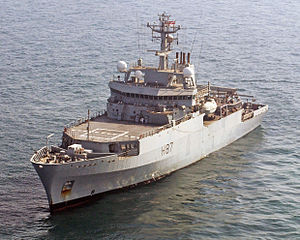| Echo-class survey ship (2002) | |
|---|---|
 HMS Echo in 2006 | |
| Class overview | |
| Builders: | Appledore Shipbuilders, Bideford (Subcontracted from Vosper Thornycroft) |
| Operators: |
|
| Built: | 2000–2003 |
| In commission: | 2003– |
| Completed: | 2 |
| Active: | 2: Echo, Enterprise |
| General characteristics [1] | |
| Displacement: | 3,470 t (3,415 long tons) |
| Length: | 90.6 m (297 ft 3 in) |
| Beam: | 16.8 m (55 ft 1 in) |
| Draught: | 5.5 m (18 ft 1 in) |
| Propulsion: |
Diesel-electric 3 × diesel generators (4.8 MW) 2 × 1.7 MW (2,279 hp) azimuth thrusters 1 × 0.4 MW (536 hp) bow thruster |
| Speed: | 15 knots (28 km/h; 17 mph) |
| Range: | 9,300 nmi (17,200 km) at 12 kn (22 km/h; 14 mph) |
| Endurance: | 35 days |
| Complement: | 72 |
| Sensors and processing systems: |
Side-scan sonar Multi-beam echo sounder Single-beam echo sounder Undulating oceanographic profiler Doppler current log Sub-bottom profiler Bottom sampling equipment |
| Armament: |
|
The Echo-class is a class of hydrographic survey ships in commission with the British Royal Navy tasked with conducting survey work in support of submarine and amphibious operations. The two vessels of the class are the most recent additions to the Royal Navy's Hydrographic Squadron. Each ship displaces approximately 3,500 tonnes, and is equipped with a state of the art suite of equipment.
Design[]
Echo and Enterprise are the first Royal Navy ships to be fitted with azimuth thrusters. Both azimuth thrusters and the bow thruster can be controlled through the integrated navigation system by a joystick providing high manoeuvrability. Complete control and monitoring for power generation and propulsion, together with all auxiliary plant systems, tank gauging and damage control functions is provided through the integrated platform management system (IPMS), accessible through workstations around the ship. The range of equipment carried includes the following:[1]
- Multi beam echo sounder
- Single beam echo sounder
- Survey Planning and Processing Systems
- Side-scan sonar
- Oceanographic Probe and sensors
- Undulating Oceanographic Profiler
- Doppler Current Log
- Sub-bottom Profiler
- Bottom Sampling Equipment
- Survey motor boat fitted with multi-beam sonar and sidescan sonar
Role[]
The vessels are designed to conduct survey tasks in support of submarines or amphibious operations. They can provide almost real-time tailored environmental information, and also have a secondary role as a mine countermeasure tasking authority platform, for which they are capable of embarking a dedicated mine counter measures command team, and supporting other mine warfare vessels.[2]
Manning[]
The two ships follow the same type of crew rotation pattern as HMS Scott, in that two-thirds of their crew is needed to keep the ship operational, with the remaining one-third ashore. This allows each ship to be available for deployment for up to 330 days a year.[3]
The ship's crew consists of 72 personnel, with 48 on board at any one time, working a cycle of 75 days on, 30 days off. The ships are able to accommodate 81 personnel if necessary. In support of this high availability, all accommodation and recreational facilities are designed for an unusual (in a warship) degree of comfort. All personnel share double cabins with private facilities, except the captain and executive officer who both have single cabins.[4]

HMS Enterprise in Dartmouth, 2008
Ships[]
| Name | Pennant | Builder | Ordered | Launched | Commissioned |
|---|---|---|---|---|---|
| Echo | H87 | Appledore Shipbuilders, Bideford[1] | 19 June 2000[1] | 4 March 2002[1] | 7 March 2003[1] |
| Enterprise | H88 | Appledore Shipbuilders, Bideford[1] | 19 June 2000[1] | 2 May 2002[1] | 17 October 2003[1] |
See also[]
| Wikimedia Commons has media related to Echo class survey ship. |
Notes[]
- ↑ 1.0 1.1 1.2 1.3 1.4 1.5 1.6 1.7 1.8 1.9 Jane's Fighting Ships, 2004-2005. Jane's Information Group Limited. p. 815. ISBN 0-7106-2623-1.
- ↑ "Echoes of a varied history - HMS Echo', ship of the month May 2004". Navy News. http://www.navynews.co.uk/ships/echo.asp. Retrieved 2009-06-20.
- ↑ "Navy's new survey ship named Enterprise". The Defence Procurement Agency Press Office. 2002-05-02. http://www.ginfo.pl/more/301211,navy,,39,s,new,survey,vessel,named,enterprise.html. Retrieved 2009-06-20.
- ↑ "Hydrographic Vessels Operation and Support at the Royal Navy website". http://www.royalnavy.mod.uk/operations-and-support/surface-fleet/hydrographic-vessels/multi-role-survey-vessels/. Retrieved 2009-06-20.
The original article can be found at Echo-class survey ship (2002) and the edit history here.